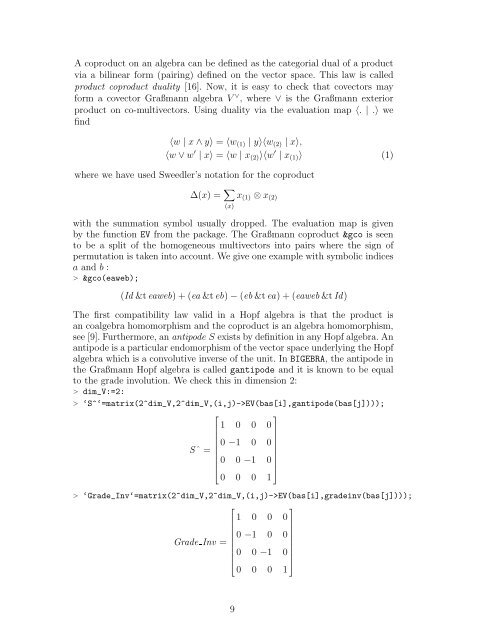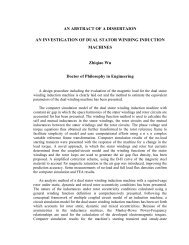CLIFFORD AND GRASSMANN HOPF ALGEBRAS VIA THE ...
CLIFFORD AND GRASSMANN HOPF ALGEBRAS VIA THE ...
CLIFFORD AND GRASSMANN HOPF ALGEBRAS VIA THE ...
You also want an ePaper? Increase the reach of your titles
YUMPU automatically turns print PDFs into web optimized ePapers that Google loves.
A coproduct on an algebra can be defined as the categorial dual of a product<br />
via a bilinear form (pairing) defined on the vector space. This law is called<br />
product coproduct duality [16]. Now, it is easy to check that covectors may<br />
form a covector Graßmann algebra V ∨ , where ∨ is the Graßmann exterior<br />
product on co-multivectors. Using duality via the evaluation map 〈. | .〉 we<br />
find<br />
〈w | x ∧ y〉 = 〈w(1) | y〉〈w(2) | x〉,<br />
〈w ∨ w ′ | x〉 = 〈w | x(2)〉〈w ′ | x(1)〉 (1)<br />
where we have used Sweedler’s notation for the coproduct<br />
∆(x) = �<br />
x(1) ⊗ x(2)<br />
(x)<br />
with the summation symbol usually dropped. The evaluation map is given<br />
by the function EV from the package. The Graßmann coproduct &gco is seen<br />
to be a split of the homogeneous multivectors into pairs where the sign of<br />
permutation is taken into account. We give one example with symbolic indices<br />
a and b :<br />
> &gco(eaweb);<br />
(Id &t eaweb)+(ea &t eb) − (eb &t ea)+(eaweb &t Id)<br />
The first compatibility law valid in a Hopf algebra is that the product is<br />
an coalgebra homomorphism and the coproduct is an algebra homomorphism,<br />
see [9]. Furthermore, an antipode S exists by definition in any Hopf algebra. An<br />
antipode is a particular endomorphism of the vector space underlying the Hopf<br />
algebra which is a convolutive inverse of the unit. In BIGEBRA, the antipode in<br />
the Graßmann Hopf algebra is called gantipode and it is known to be equal<br />
to the grade involution. We check this in dimension 2:<br />
> dim_V:=2:<br />
> ‘S^‘=matrix(2^dim_V,2^dim_V,(i,j)->EV(bas[i],gantipode(bas[j])));<br />
⎡<br />
⎤<br />
⎢ 1 0 0 0⎥<br />
⎢<br />
⎥<br />
⎢<br />
⎥<br />
⎢ 0 −1 0 0⎥<br />
Sˆ = ⎢<br />
⎥<br />
⎢<br />
⎥<br />
⎢ 0 0 −1 0 ⎥<br />
⎣<br />
⎦<br />
0 0 0 1<br />
> ‘Grade_Inv‘=matrix(2^dim_V,2^dim_V,(i,j)->EV(bas[i],gradeinv(bas[j])));<br />
⎡<br />
⎤<br />
⎢ 1 0 0<br />
⎢ 0 −1 0<br />
Grade Inv = ⎢ 0 0 −1<br />
⎣<br />
0 ⎥<br />
0 ⎥<br />
0 ⎥<br />
⎦<br />
0 0 0 1<br />
9
















